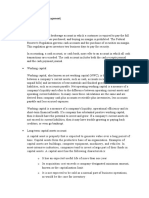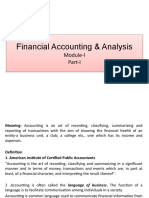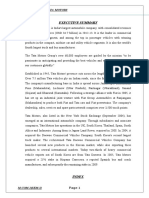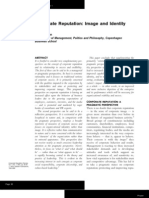Bunwin Residence: Is The Company Profitable??
Bunwin Residence: Is The Company Profitable??
Uploaded by
Pum MineaCopyright:
Available Formats
Bunwin Residence: Is The Company Profitable??
Bunwin Residence: Is The Company Profitable??
Uploaded by
Pum MineaOriginal Description:
Original Title
Copyright
Available Formats
Share this document
Did you find this document useful?
Is this content inappropriate?
Copyright:
Available Formats
Bunwin Residence: Is The Company Profitable??
Bunwin Residence: Is The Company Profitable??
Uploaded by
Pum MineaCopyright:
Available Formats
Bunwin Residence
Siem Reap, Kingdom of Cambodia
Getting to Know Accounting
1. Introduction
Accounting is the language of business. It is the system of recording, summarizing, and analyzing an economic entity's financial transactions. Effectively communicating this information is key to the success of every business. Those who rely on financial information include internal users, such as a company's managers and employees, and external users, such as banks, investors, governmental agencies, financial analysts, and labor unions. These users depend upon data supplied by accountants to answer the following types of questions:
Is there enough cash to meet payroll needs? How much debt does the company have? How does the company's net income compare to its budget? What is the balance owed by customers? Has the company consistently paid cash dividends? How much income does each division generate? Should the company invest money to expand?
Is the company profitable??
Accountants must present an organization's financial information in clear, concise reports that help make questions like these easy to answer. The most common accounting reports are called financial statements.
Page 1 of 6
2. The Accounting Equation
The ability to read financial statements requires an understanding of the items they include and the standard categories used to classify these items. The accounting equation identifies the relationship between the elements of accounting.
Assets. An asset is something of value the company owns. Assets can be tangible or intangible. Tangible assets are generally divided into three major categories: current assets (including cash, marketable securities, accounts receivable, inventory, and prepaid expenses); property, plant, and equipment; and longterm investments. Intangible assets lack physical substance, but they may, nevertheless, provide substantial value to the company that owns them. Examples of intangible assets include patents, copyrights, trademarks, and franchise licenses. A brief description of some tangible assets follows. Current assets typically include cash and assets the company reasonably expects to use, sell, or collect within one year. Current assets appear on the balance sheet (and in the numbered list below) in order, from most liquid to least liquid. Liquid assets are readily convertible into cash or other assets, and they are generally accepted as payment for liabilities. 1. Cash includes cash on hand (petty cash), bank balances (checking, savings, or money-market accounts), and cash equivalents. Cash equivalents are highly liquid investments, such as certificates of deposit and U.S. treasury bills, with maturities of ninety days or less at the time of purchase. 2. Marketable securities include short-term investments in stocks, bonds (debt), certificates of deposit, or other securities. These items are classified as marketable securitiesrather than long-term investmentsonly if the company has both the ability and the desire to sell them within one year. 3. Accounts receivable are amounts owed to the company by customers who have received products or services but have not yet paid for them. 4. Inventory is the cost to acquire or manufacture merchandise for sale to customers. Although service enterprises that never provide customers with merchandise do not use this category for current assets, inventory usually represents a significant portion of assets in merchandising and manufacturing companies. 5. Prepaid expenses are amounts paid by the company to purchase items or services that represent future costs of doing business. Examples include office supplies, insurance premiums, and advance payments for rent. These assets become expenses as they expire or get used up. Property, plant, and equipment is the title given to long-lived assets the business uses to help generate revenue. This category is sometimes called fixed assets. Examples include land, natural resources such as timber or mineral reserves, buildings, production equipment, vehicles, and office furniture. With the exception of
Page 2 of 6
land, the cost of an asset in this category is allocated to expense over the asset's estimated useful life. Long-term investments include purchases of debt or stock issued by other companies and investments with other companies in joint ventures. Long-term
investments differ from marketable securities because the company intends to hold long-term investments for more than one year or the securities are not marketable. Liabilities. Liabilities are the company's existing debts and obligations owed to third parties. Examples include amounts owed to suppliers for goods or services received (accounts payable), to employees for work performed (wages payable), and to banks for principal and interest on loans (notes payable and interest payable). Liabilities are generally classified as shortterm (current) if they are due in one year or less. Long term liabilities are not due for at least one year. Owner's equity. Owner's equity represents the amount owed to the owner or owners by the company. Algebraically, this amount is calculated by subtracting liabilities from each side of the accounting equation. Owner's equity also represents the net assets of the company.
In a sole proprietorship or partnership, owner's equity equals the total net investment in the business plus the net income or loss generated during the business's life. Net investment equals the sum of all investment in the business by the owner or owners minus withdrawals made by the owner or owners. The owner's investment is recorded in the owner's capital account, and any withdrawals are recorded in a separate owner's drawing account. For example, if a business owner contributes $10,000 to start a company but later withdraws $1,000 for personal expenses, the owner's net investment equals $9,000. Net income or net lossequals the company's revenues less its expenses. Revenues are inflows of money or other assets received from customers in exchange for goods or services.Expenses are the costs incurred to generate those revenues.
Page 3 of 6
Capital investments and revenues increase owner's equity, while expenses and owner withdrawals (drawings) decrease owner's equity. In a partnership, there are separate capital and drawing accounts for each partner. Stockholders' equity. In a corporation, ownership is represented by shares of stock, so the owners' equity. is called stockholders' equity or shareholders' equity. Corporations use several types of accounts to record stockholders' equity activities: preferred stock, common stock, paidin capital (these are often referred to as contributed capital), and retained earnings. Contributed capital accounts record the total amount invested by stockholders in the corporation. If a corporation issues more than one class of stock, separate accounts are maintained for each class. Retained earnings equal net income or loss over the life of the business less any amounts given back to stockholders in the form of dividends. Dividends affect stockholders' equity in the same way that owner withdrawals affect owner's equity in sole proprietorships and partnerships.
Page 4 of 6
3. Financial Reporting Objectives
Financial statements are prepared according to agreed upon guidelines. In order to understand these guidelines, it helps to understand the objectives of financial reporting. The objectives of financial reporting, as discussed in the Financial Accounting standards Board (FASB) Statement of Financial Accounting Concepts No. 1, are to provide information that:
1. Is useful to existing and potential investors and creditors and other users in making rational investment, credit, and similar decisions; 2. Helps existing and potential investors and creditors and other user to assess the amounts, timing, and uncertainty of prospective net cash inflows to the enterprise; 3. Identifies the economic resources of an enterprise, the claims to those resources, and the effects that transactions, events, and
4. Internal Control
Internal control is the process designed to ensure reliable financial reporting, effective and efficient operations, and compliance with applicable laws and regulations. Safeguarding assets against theft and unauthorized use, acquisition, or disposal is also part of internal control. Control environment. The management style and the expectations of upper level managers, particularly their control policies, determine the control environment. An effective control environment helps ensure that established policies and procedures are followed. The control environment includes independent oversight provided by a board of directors and, in publicly held companies, by an audit committee; management's integrity, ethical values, and philosophy; a defined organizational structure with competent and trustworthy employees; and the assignment of authority and responsibility. Control activities. Control activities are the specific policies and procedures management uses to achieve its objectives. The most important control activities involve segregation of duties, proper authorization of transactions and activities, adequate documents and records, physical control over assets and records, and independent checks on performance. A short description of each of these control activities appears below. Segregation of duties requires that different individuals be assigned responsibility for different elements of related activities, particularly those involving authorization, custody, or recordkeeping. For example, the same person who is responsible for an asset's recordkeeping should not be respon sible for physical control of that asset Having different indi viduals perform these functions creates a system of checks and balances.
Page 5 of 6
Proper authorization of transactions and activities helps ensure that all company activities adhere to established guide lines unless responsible managers authorize another course of action. For example, a fixed price list may serve as an official authorization of price for a large sales staff. In addition, there may be a control to allow a sales manager to authorize reason able deviations from the price list. Adequate documents and records provide evidence that financial statements are accurate. Controls designed to ensure adequate recordkeeping include the creation of invoices and other documents that are easy to use and sufficiently informa tive; the use of prenumbered, consecutive documents; and the timely preparation of documents. Physical control over assets and records helps protect the company's assets. These control activities may include elec tronic or mechanical controls (such as a safe, employee ID cards, fences, cash registers, fireproof files, and locks) or computerrelated controls dealing with access privileges or established backup and recovery procedures. Independent checks on performance, which are carried out by employees who did not do the work being checked, help ensure the reliability of accounting information and the efficiency of operations. For example, a supervisor verifies the accuracy of a retail clerk's cash drawer at the end of the day. Internal auditors may also verity that the supervisor performed the check of the cash drawer.
In order to identify and establish effective controls, management must continually assess the risk, monitor control implementation, and modify controls as needed. Top managers of publicly held companies must sign a statement of responsibility for internal controls and include this statement in their annual report to stockholders.
Page 6 of 6
You might also like
- Understanding Financial Statements (Review and Analysis of Straub's Book)From EverandUnderstanding Financial Statements (Review and Analysis of Straub's Book)Rating: 5 out of 5 stars5/5 (5)
- Series 79 CL 1Document68 pagesSeries 79 CL 1barlie3824100% (1)
- Social Cost Benefit AnalysisDocument60 pagesSocial Cost Benefit AnalysisAmmrita SharmaNo ratings yet
- Encana FinalDocument15 pagesEncana FinalSushant Rajputra100% (3)
- Zacks Rank Guide: Harnessing The Power of Earnings Estimate RevisionsDocument25 pagesZacks Rank Guide: Harnessing The Power of Earnings Estimate RevisionsAl AlamNo ratings yet
- Walang Pamagat Na Dokumento 2Document5 pagesWalang Pamagat Na Dokumento 2apriljanegorre29No ratings yet
- What Is Cash FlowDocument31 pagesWhat Is Cash FlowSumaira BilalNo ratings yet
- Corporate FininanceDocument10 pagesCorporate FininanceMohan KottuNo ratings yet
- The Financial StatementsDocument30 pagesThe Financial StatementsFORCHIA MAE CUTARNo ratings yet
- Finman CHPT 1Document12 pagesFinman CHPT 1Rosda DhangNo ratings yet
- The Accounting EquationDocument4 pagesThe Accounting EquationjcwimzNo ratings yet
- Balance SheetDocument8 pagesBalance SheetadjeponehNo ratings yet
- Assets: Elements of The Financial StatementsDocument5 pagesAssets: Elements of The Financial StatementsSiva PratapNo ratings yet
- CMBE 2 - Lesson 3 ModuleDocument12 pagesCMBE 2 - Lesson 3 ModuleEunice AmbrocioNo ratings yet
- Aurah Cantika RDocument11 pagesAurah Cantika Rreskiyanishara97No ratings yet
- Unit 1Document23 pagesUnit 1Katlego ThaboNo ratings yet
- Basic Accounting.Document3 pagesBasic Accounting.Sanjay MeenaNo ratings yet
- Malvik ProjectDocument95 pagesMalvik ProjectKamal ShahNo ratings yet
- In Business and AccountingDocument6 pagesIn Business and AccountingHarish AroraNo ratings yet
- FINANCIAL STATEMENT For PrintDocument4 pagesFINANCIAL STATEMENT For PrintGkgolam KibriaNo ratings yet
- Cryptocurrency TodayDocument22 pagesCryptocurrency TodayErralyn PenafloridaNo ratings yet
- Chapter-1Document5 pagesChapter-1юрий локтионовNo ratings yet
- Accounting BasicsDocument13 pagesAccounting BasicskameshpatilNo ratings yet
- Unit 4Document28 pagesUnit 4Abraham JohnNo ratings yet
- Ans.Q1) Accounting Is The Process of Recording Financial Transactions Pertaining To ADocument8 pagesAns.Q1) Accounting Is The Process of Recording Financial Transactions Pertaining To ALavina AgarwalNo ratings yet
- Accounting Is An Information System That IdentifiesDocument5 pagesAccounting Is An Information System That Identifiesniser88No ratings yet
- Accounting: 2.financial StatementsDocument4 pagesAccounting: 2.financial StatementsYinan CuiNo ratings yet
- Discussion Board #2 Financial StatementsDocument3 pagesDiscussion Board #2 Financial StatementsMahmoud SheblNo ratings yet
- Stock ResearchDocument50 pagesStock Researchvikas yadavNo ratings yet
- 02 Handout 1Document6 pages02 Handout 1Stacy Anne LucidoNo ratings yet
- Financial StatementDocument16 pagesFinancial StatementCuracho100% (1)
- Balance Sheet Assets Liabilities Income StatementDocument4 pagesBalance Sheet Assets Liabilities Income Statementmadhav5544100% (1)
- Accounting Module E BookDocument43 pagesAccounting Module E BookMahima SheromiNo ratings yet
- Personal Assets: AssetDocument6 pagesPersonal Assets: AssetDipak NandeshwarNo ratings yet
- Intao - Feasibilty Study (Financial Feasibility Part2)Document9 pagesIntao - Feasibilty Study (Financial Feasibility Part2)Mary Jane Arca IntaoNo ratings yet
- Chapter 2: Accounting Equation and The Double-Entry SystemDocument15 pagesChapter 2: Accounting Equation and The Double-Entry SystemSteffane Mae Sasutil100% (1)
- Chapter 2: Accounting Equation and The Double-Entry SystemDocument15 pagesChapter 2: Accounting Equation and The Double-Entry SystemSteffane Mae SasutilNo ratings yet
- Understanding The Balance SheetDocument11 pagesUnderstanding The Balance Sheetosuna.osiris100% (1)
- Chapter 7 Accounting and Financial ConsiderationsDocument32 pagesChapter 7 Accounting and Financial ConsiderationsErwin MatunanNo ratings yet
- Social AccountingDocument28 pagesSocial Accountingfeiyuqing_276100% (1)
- Financial StatementsDocument9 pagesFinancial StatementsKaylie MCginnNo ratings yet
- A Balance SheetDocument3 pagesA Balance SheetKarthik ThotaNo ratings yet
- Accounting - DefinitionsDocument4 pagesAccounting - DefinitionsYashi SharmaNo ratings yet
- 1financial ManagementDocument8 pages1financial ManagementHenkVriesNo ratings yet
- 1Document1 page1faheemsadatkhanNo ratings yet
- Tutorial 3 (Financial Management)Document2 pagesTutorial 3 (Financial Management)muthuNo ratings yet
- Financialfeasibility 200129141325Document20 pagesFinancialfeasibility 200129141325Princess BaybayNo ratings yet
- DocumentDocument8 pagesDocumentDivyansh SinghNo ratings yet
- 2600 Legarda St. Sampaloc, Manila: Arellano University Juan Sumulong Campus Senior High School DepartmentDocument7 pages2600 Legarda St. Sampaloc, Manila: Arellano University Juan Sumulong Campus Senior High School DepartmentTrisha TorresNo ratings yet
- Financial AccountingDocument77 pagesFinancial Accountingamna.g24689No ratings yet
- Financial ReportDocument3 pagesFinancial Reportlina vyxNo ratings yet
- BACNTHIDocument3 pagesBACNTHIFaith CalingoNo ratings yet
- Fme Accounting Terminology ChecklistDocument6 pagesFme Accounting Terminology ChecklistPartha BoyalNo ratings yet
- Statement of Financial PositionDocument17 pagesStatement of Financial PositionJing BJYXNo ratings yet
- Chapter 3 SummaryDocument3 pagesChapter 3 SummaryDarlianne Klyne BayerNo ratings yet
- Shareholders Equity LectureDocument11 pagesShareholders Equity Lecturecaciafaithgarcia.capuno12No ratings yet
- Faa IDocument18 pagesFaa INishtha RathNo ratings yet
- Anglais s1Document9 pagesAnglais s1JassNo ratings yet
- Components of Financial StatementDocument4 pagesComponents of Financial StatementsonuNo ratings yet
- Chapter 2 HandoutsDocument15 pagesChapter 2 HandoutsBlackpink BtsNo ratings yet
- Right When You Thought Theory Was Completed!Document4 pagesRight When You Thought Theory Was Completed!your helperNo ratings yet
- 2 Elements of AccountingDocument4 pages2 Elements of Accountingapi-299265916No ratings yet
- ACTBAS1 - Lesson 2 (Statement of Financial Position)Document47 pagesACTBAS1 - Lesson 2 (Statement of Financial Position)AyniNuydaNo ratings yet
- Chapter 1-Directed Reading WorksheetDocument9 pagesChapter 1-Directed Reading WorksheetfeyzaNo ratings yet
- Coin - Central Bank of Kuwait - Coins, Notes+SpecialIssuesDocument7 pagesCoin - Central Bank of Kuwait - Coins, Notes+SpecialIssuesrossmckenzieNo ratings yet
- FDI and Political RiskDocument59 pagesFDI and Political RiskannNo ratings yet
- Dorset Energy Fund Up 50 Percent Topping Hedge Fund Performance ListDocument1 pageDorset Energy Fund Up 50 Percent Topping Hedge Fund Performance ListPeter BatsakisNo ratings yet
- Container Ports: An Engine of Growth: Sectoral ReportDocument28 pagesContainer Ports: An Engine of Growth: Sectoral ReportpriyankchhabraNo ratings yet
- Suzlon - Swot AnalysisDocument17 pagesSuzlon - Swot AnalysisVaradharajulu RajaNo ratings yet
- 04-09-2016 First ShiftDocument61 pages04-09-2016 First Shiftsaurabh dabas100% (1)
- Financial Accounting March 2009 Marks PlanDocument14 pagesFinancial Accounting March 2009 Marks Plankarlr9No ratings yet
- AuditDocument40 pagesAuditRkenterprise50% (2)
- Comparative Study of Reliance & Birla SunlifeDocument64 pagesComparative Study of Reliance & Birla SunlifeRohitParjapat100% (1)
- Summer T in HindalcoDocument82 pagesSummer T in HindalcoJohev Khan100% (2)
- Chap 2-Financial Statements, Cash Flows and TaxesDocument14 pagesChap 2-Financial Statements, Cash Flows and TaxesAnum IrfanNo ratings yet
- Atlp Practice Questions Direct Tax & International TaxationDocument82 pagesAtlp Practice Questions Direct Tax & International Taxationharsh bangNo ratings yet
- A GUIDE TO TRULY RICH CLUB by BO SANCHEZDocument4 pagesA GUIDE TO TRULY RICH CLUB by BO SANCHEZRaymunda Rauto-avilaNo ratings yet
- China Medical Technologies Chapter 15 ProceedingDocument17 pagesChina Medical Technologies Chapter 15 ProceedingDistressedDebtInvestNo ratings yet
- Asst. Prof. Rishi Dev ALS AUMDocument9 pagesAsst. Prof. Rishi Dev ALS AUMjoy parimalaNo ratings yet
- Ran Duchin CVDocument7 pagesRan Duchin CVsids_dch2173No ratings yet
- Business Combination and Consolidation On Acquisition Date SummaryDocument6 pagesBusiness Combination and Consolidation On Acquisition Date SummaryWilmar Abriol100% (1)
- Case-Analyses Presentation "House of Tata: Acquiring A Global Footprint"Document36 pagesCase-Analyses Presentation "House of Tata: Acquiring A Global Footprint"Mohit ManaktalaNo ratings yet
- Corporate Reputation: Image and IdentityDocument15 pagesCorporate Reputation: Image and IdentityInês PereiraNo ratings yet
- How Russian Tycoon Yuri Milner Bought His Way Into Silicon ValleyDocument15 pagesHow Russian Tycoon Yuri Milner Bought His Way Into Silicon ValleyJoel Y. OkamaNo ratings yet
- Chapter 3Document52 pagesChapter 3Jen NieNo ratings yet
- Financial Literacy and Preparedness: Claire C. Imperial Nicole I. Encinas Michael D. Paitan Angielyn A. CubillasDocument37 pagesFinancial Literacy and Preparedness: Claire C. Imperial Nicole I. Encinas Michael D. Paitan Angielyn A. CubillasMichael Data Paitan100% (6)
- Overcoming The Fear of The UnknownDocument5 pagesOvercoming The Fear of The UnknownBharat SahniNo ratings yet
- Partnership MidtermDocument10 pagesPartnership MidtermJoanna Caballero100% (1)
- Financial Education Facilitator ManualDocument12 pagesFinancial Education Facilitator ManualNicholas MundiaNo ratings yet
- Research ProposalDocument4 pagesResearch Proposalsalman100% (2)

























































































